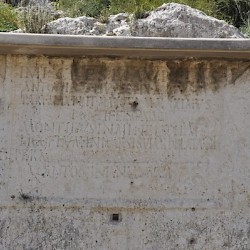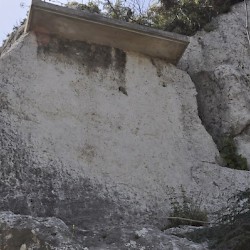Lykos (Nahr al-Kalb)
Q1963736Lykos or Nahr al-Kalb: river, northeast of modern Beirut, best known for a large series of rock inscriptions, both ancient and modern.

The Lykos river is a remarkable place. Winter storms blowing down the gorge make a howling noise, which explains the name of this river, which means "wolf". The present name, Nahr al-Kalb, means "dog river".
In the thirteenth century BCE, the Egyptian king Ramesses II left three reliefs on the south bank of the Nahr al-Kalb, north of Berytus, which commemorated the northern campaigns that culminated in the battle of Kadesh (1274 BCE). Several centuries later, the Assyrian king Esarhaddon, having forced cities like Tyre into submission, conquered Egypt, and chose to put a memorial of his own opposite the relief of Ramesses. Ever since, armies have left inscription at the Nahr al-Kalb, a custom that was known to the Greek researcher Herodotus of Halicarnassus (more).
All in all, there are twenty-two inscriptions and two monuments, with texts in seven languages: Egyptian, Assyrian, Greek, Latin, Arabic, French, and English. There is also the pedestal of a statue of an animal, which may have been a wolf or dog (cf. the name of the river). The making of stelas in this area is mentioned in several Assyrian texts (example).
In Chronological Order
| 14 | 1275 | The god Ra gives the sword of victory to Ramesses II after his First Syrian Campaign; "year four" is still legible |
| 16 | 1269 | In front of the god Amun, Ramesses II is about to strike at an enemy, after his Sixth Syrian Campaign; "year ten" is still legible |
| 8 | Unknown | Ramesses II slaying an enemy in front of the god Ptah; probably, the relief mentioned by Herodotus (more) |
| 17 | 671 | Esarhaddon, after conquering Egypt |
| 6 | Unknown | Unidentified Assyrian king |
| 7 | Unknown | Unidentified Assyrian king |
| 13 | Unknown | Unidentified Assyrian king |
| 15 | Unknown | Unidentified Assyrian king |
| 1 | 605-562 | The Babylonian king Nebuchadznezzar |
| 12 | Third century BCE | Unidentified Hellenistic king, perhaps Antiochus III the Great after his victory in the Fifth Syrian War |
| 3 | 215 CE | The Roman emperor Caracalla, travelling from Antioch to Alexandria (CIL 3.206) |
| 11 | 382-383 | Inscription by governor Proculus of Phoenicia, who built a road and sacrificed in Baalbek |
| 2 | 1382-1399 | Inscription to commemorate the building of a bridge by the Mamluq sultan Barquq |
| 5 | 1861 | Inscription of Napoleon III to commemorate a French intervention in the conflict between Druzes and Maronites |
| 18 | 1901 | Text on an Ottoman bridge |
| 9 | 1918 | Collapse of the Ottoman Empire: Capture of Damascus, Homs, and Aleppo by Arab and Allied troops |
| 10 | 1918 | Collapse of the Ottoman Empire: Capture of Beirut by French and British troops |
| 4 | 1920 | French intervention in Syria: general Gouraud's inscription to commemorate general Goybet's victory at Maysalun, and the entry of French troops into Damascus |
| - | 1927 | Monument for the French garrison of Beirut (originally from Beirut, moved to this place after the Mandate of the League of Nations had ended) |
| 19 | 1941 | The Free French liberate Damascus from Vichy troops |
| 20 | 1942 | Text on railroad bridge |
| 21 | 1946 | Evacuation of the foreign forces from Lebanon; beginning of the independence |
| 22 | 2000 | Evacuation of the Israeli forces from southern Lebanon |
From East to West

If you want to visit the place and arrive from Beirut, you must follow the coastal road to Jubayl (ancient Byblos) and turn right immediately after the tunnel. Continue for some 400 meters; there's a Medieval bridge, built by the Mamluk sultan Qalawun (r.1279-1290). Here, you can park your car, and here you will find inscription #2. Walking back in the direction of the tunnel, you will pass several other monuments.
There's a passage over the tunnel, after which the path winds itself up the hill. Inscription #15 is on the summit, and you will see the interesting #16 and #17 if you proceed and go down again. There is also the pedestal of the ancient statue of a dog or wolf: nowadays nothing but a damaged stone, but one day a monument that must have caught everybody's attention.
| In the valley, between the Medieval bridge and the tunnel | ||
| 2 | 1382-1399 | Barquq (Mamluq sultan) |
| 3 | 215 | Caracalla |
| - | Monument French garrison of Beirut | |
| 18 | 1901 | Inscription on Ottoman bridge |
| 19 | 1941 | Liberation of Damascus |
| 4 | 1920 | General Gouraud |
| 22 | 2000 | Evacuation of the Israeli Forces |
| 21 | 1946 | Evacuation of foreign forces |
| 5=8 | 1861 | Napoleon III (replaced inscr. Rameses II) |
| 6 | Unknown | Unidentified Assyrian king |
| 9 | 1918 | Capture of Damascus |
| 7 | Unknown | Unidentified Assyrian king |
| 10 | 1918 | Occupation of Beirut |
| Beginning of the passage over the main road | ||
| 11 | 382/383 | Proculus |
| End of the passage; the inscriptions below are on the rock itself | ||
| 20 | 1942 | Railroad inscription |
| 12 | Third century BCE | Unidentified Hellenistic king |
| Pedestal of a statue of a dog or wolf | ||
| 13 | Unknown | Unidentified Assyrian king |
| 14 | 1275 | Ramesses II |
| 15 | Unknown | Unidentified Assyrian king |
| 16 | 1269 | Ramesses II |
| 17 | 677/676 | Esarhaddon |
| 1 | 605-562 | Nebuchadnezzar (across the river) |
Literature
Anne-Marie Maïla-Afeiche e.a. "Le site de Nahr el-Kalb", special issue of Bulletin d'archéologie et d'architecture Libanais (2009)



















